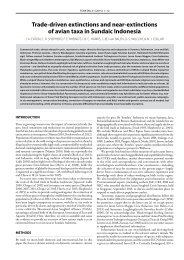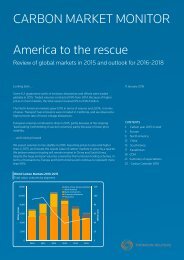Emissions Trading Worldwide
1TbjEHd
1TbjEHd
You also want an ePaper? Increase the reach of your titles
YUMPU automatically turns print PDFs into web optimized ePapers that Google loves.
Chongqing (Pilot) <strong>Emissions</strong> <strong>Trading</strong> Scheme<br />
in force<br />
emissions coverage (Mtco 2 e, 2014)<br />
Liable entities<br />
106 237<br />
Gas coverage<br />
allocation<br />
Offsets & Credits<br />
several gases<br />
free allocation<br />
domestic<br />
On 19 June 2014, Chongqing was the latest Chinese region to<br />
start its pilot ETS. The system covers enterprises from seven sectors:<br />
power, electrolytic aluminum, ferroalloys, calcium carbide,<br />
cement, caustic soda, and iron and steel. The 242 covered enterprises<br />
account for around 40% of the city’s total emissions.<br />
background information<br />
Overall Ghg <strong>Emissions</strong> (excl. LULUCF) 243.1 MtCO 2 e (2012)<br />
GHG Reduction Targets By 2015: (12 th Five Year Plan): 17% reduction in carbon<br />
intensity compared to 2010 levels.<br />
Flexibility<br />
Banking and borrowing Banking allowed during the pilot phase.<br />
Borrowing is not allowed.<br />
Offsets and Credits Quantitative Limit: Domestic project-based carbon offset<br />
credits — China Certified Emission Reductions (CCERs)— are allowed with<br />
a maximum amount of 8% of the compliance obligation. Qualitative Limit:<br />
Reductions have to be achieved after 2010 with the exception of carbon sink<br />
projects. Credits from hydro projects are not allowed.<br />
PRICE MANAGEMENT PROVISIONS In case of market fluctuations, the<br />
Chongqing Carbon <strong>Emissions</strong> Exchange can take price stabilization measures.<br />
Compliance entities must not sell more than 50% of their free allocation.<br />
ets size<br />
compliance<br />
Cap 106 MtCO 2e (2014)<br />
emissions coverage<br />
covered<br />
not covered<br />
40%<br />
60 %<br />
GHG Covered CO 2, CH 4, N 2 O, HFCs, PFCs, SF 6<br />
Sectors & THRESHOLDS Power, electrolytic aluminum, ferroalloys, calcium<br />
carbide, cement, caustic soda, and iron and steel. Inclusion thresholds:<br />
20,000t CO 2e/year.<br />
Point of regulation Mixed: Both direct emissions from the power sector<br />
and indirect emissions from electricity (and heat) consumption are included in<br />
the scheme. Electricity prices are regulated in China, and therefore a scheme<br />
based on direct emissions alone would not induce a pass-through of carbon<br />
costs via the electricity price, and would not incentivize demand-side management<br />
of electricity. The system therefore covers emissions from the power sector<br />
upstream and other sectors downstream.<br />
Number of liable entities 237 (2014)<br />
MRV Reporting Frequency: Annual reporting of GHG emissions. verification:<br />
Third-party verification is required. Framework: The Chongqing Development<br />
and Reform Commission (DRC) released a guiding document for monitoring<br />
and reporting that includes methods for different emissions sources: combustion,<br />
industrial processes and electricity consumption.<br />
Enforcement According to the Interim Administrative Measures for the<br />
Chongqing ETS published on May 2014, there are no financial penalties for<br />
non-compliance. The punishments may include media reporting and public<br />
exposure of the noncompliance, disqualification from the energy saving and<br />
climate subsidies, as well as associated awards for three years; records on the<br />
State Owned Enterprise (SOE) performance assessment system.<br />
other information<br />
Institutions involved Chongqing DRC (Competent authority), Chongqing<br />
Carbon <strong>Emissions</strong> Exchange (<strong>Trading</strong> platform)<br />
Phases and Allocation<br />
<strong>Trading</strong> periods Three years (2013–2015) 1<br />
allocation Free allocation through grandfathering based on historic emissions<br />
(highest number in period 2008–2012). If the sum of allocation for all<br />
enterprises exceeds the cap, a reduction factor is applied. Ex-post adjustments<br />
based on production data are also possible.<br />
COMPLIANCE PERIOD Due to the late start, compliance for 2013 and 2014 were<br />
combined in one phase. A one year compliance period was put in place for<br />
2015 (20 June).<br />
1 Initially, the seven Chinese pilot ETS were scheduled to end after three compliance years and be<br />
replaced by the national ETS in 2016. However, as the national ETS will not start before 2017, the pilots<br />
will likely be extended until then.<br />
60




